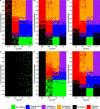Evolution of anticipatory effects mediated by epigenetic changes
- PMID: 35475265
- PMCID: PMC9031056
- DOI: 10.1093/eep/dvac007
Evolution of anticipatory effects mediated by epigenetic changes
Abstract
Anticipatory effects mediated by epigenetic changes occur when parents modify the phenotype of their offspring by making epigenetic changes in their gametes, guided by information from an environmental cue. To investigate when do anticipatory effects mediated by epigenetic changes evolve in a fluctuating environment, I use an individual-based simulation model with explicit genetic architecture. The model allows for the population to respond to environmental changes by evolving plasticity, bet hedging, or by tracking the environment with genetic adaptation, in addition to the evolution of anticipatory effects. The results show that anticipatory effects evolve when the environmental cue provides reliable information about the environment and the environment changes at intermediate rates, provided that fitness costs of anticipatory effects are rather low. Moreover, evolution of anticipatory effects is quite robust to different genetic architectures when reliability of the environmental cue is high. Anticipatory effects always give smaller fitness benefits than within-generation plasticity, suggesting a possible reason for generally small observed anticipatory effects in empirical studies.
Keywords: between-generation plasticity; genetic architecture; intergenerational effects; phenotypic plasticity; transgenerational plasticity.
© The Author(s) 2022. Published by Oxford University Press.
Figures






Similar articles
-
Can You Trust Who You See? The Evolution of Socially Cued Anticipatory Plasticity.Am Nat. 2021 Apr;197(4):E129-E142. doi: 10.1086/712919. Epub 2021 Feb 11. Am Nat. 2021. PMID: 33755539
-
How stable 'should' epigenetic modifications be? Insights from adaptive plasticity and bet hedging.Evolution. 2014 Mar;68(3):632-43. doi: 10.1111/evo.12324. Epub 2013 Dec 20. Evolution. 2014. PMID: 24274594 Review.
-
Evolutionary History Mediates Population Response to Rapid Environmental Change through Within-Generational and Transgenerational Plasticity.Am Nat. 2023 May;201(5):E90-E109. doi: 10.1086/723624. Epub 2023 Mar 29. Am Nat. 2023. PMID: 37130228
-
Environmental variation mediates the evolution of anticipatory parental effects.Evol Lett. 2020 Jun 10;4(4):371-381. doi: 10.1002/evl3.177. eCollection 2020 Aug. Evol Lett. 2020. PMID: 32774885 Free PMC article.
-
Transgenerational inheritance: how impacts to the epigenetic and genetic information of parents affect offspring health.Hum Reprod Update. 2019 Sep 11;25(5):518-540. doi: 10.1093/humupd/dmz017. Hum Reprod Update. 2019. PMID: 31374565
Cited by
-
Plant environmental memory: implications, mechanisms and opportunities for plant scientists and beyond.AoB Plants. 2023 Jun 6;15(4):plad032. doi: 10.1093/aobpla/plad032. eCollection 2023 Jul. AoB Plants. 2023. PMID: 37415723 Free PMC article. Review.
-
Differentially expressed microRNAs in brains of adult females may regulate the maternal block of diapause in Sarcophaga bullata.Curr Res Insect Sci. 2024 Sep 26;6:100099. doi: 10.1016/j.cris.2024.100099. eCollection 2024. Curr Res Insect Sci. 2024. PMID: 39431284 Free PMC article.
-
Do microbes have a memory? History-dependent behavior in the adaptation to variable environments.Front Microbiol. 2022 Oct 10;13:1004488. doi: 10.3389/fmicb.2022.1004488. eCollection 2022. Front Microbiol. 2022. PMID: 36299722 Free PMC article. Review.
-
Heritable epigenetic variation facilitates long-term maintenance of epigenetic and genetic variation.G3 (Bethesda). 2024 Feb 7;14(2):jkad287. doi: 10.1093/g3journal/jkad287. G3 (Bethesda). 2024. PMID: 38113034 Free PMC article.
-
Nematode mind: exploring the role of the RNA interference pathway in learning, memory and beyond.Philos Trans R Soc Lond B Biol Sci. 2025 Jun 26;380(1929):20240125. doi: 10.1098/rstb.2024.0125. Epub 2025 Jun 26. Philos Trans R Soc Lond B Biol Sci. 2025. PMID: 40566921 Free PMC article.
References
-
- Marshall JD, Uller T.. When is a maternal effect adaptive? Oikos 2007;116:1957–63. doi: 10.1111/j.2007.0030-1299.16203.x - DOI
-
- Kronholm I. Handbook of Epigenetics: The New Molecular and Medical Genetics , 2nd edn. (Ed. Tollefsbol T.), Adaptive evolution and epigenetics, Academic Press, 2017, 427–38.
LinkOut - more resources
Full Text Sources

